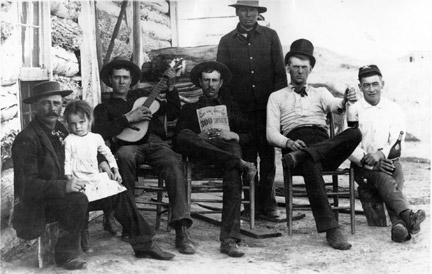
Twelfth Infantry soldiers and a policeman relaxing at Fort Yates, North Dakota. V101-13
Indian Wars Widows Project Records
JEFF-9015, Record Unit 101
For the first time, the object of the month is an archival collection, so I would like to explain a bit about the nature of archival collections and why an entire set of papers and photographs is cataloged as one unit.
Unlike a single artifact, an archival collection gains significance only in being a part of the whole. The individual parts of the collection may be interesting, but it is the combination of them all, plus the story of the creation of the records, that makes the papers significant. An archival collection can be one folder of papers or a hundred boxes, but the creator of the records will tie them together.
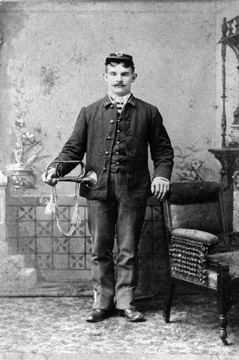
Jacob Wingender, bugler of the Twelfth Infantry, Company F taken at Fort Yates, North Dakota, circa 1890. V101-92
In this case, the collection comprises the records of park historian Don Rickey. In the 1960s, Rickey was planning exhibits for the Museum of Westward Expansion and was searching for information, letters, photos and artifacts from men who were soldiers in the United States Army in the West. Rickey undertook a project in 1962 to contact all the surviving un-remarried widows of Indian Wars Veterans who were still receiving pensions from the U.S. Department of Veterans Affairs.
The Indian Wars between American Indian tribes and European settlers began soon after the arrival of the colonists and did not let up until disease, hunger, and attrition from battlefield wounds and death forced nearly all the surviving tribes onto reservations. The final push to marginalize and force Indians onto reservations came after the American Civil War, when the still-powerful U.S. Army concentrated on eliminating the remaining semi-nomadic peoples in the trans-Mississippi West to make room for the huge influx of Anglo Americans from the East and Midwest. By 1869 a transcontinental railroad line was completed, with three more routes to the Pacific operational in the following twenty years. Settlers, miners, and many others seeking their fortune or a new life flocked to the frontier via the railroads and expected the Army to protect them from conflicts with Indian tribes.(Robert Utley, "Indian-United States Military Situation, 1848-1891.")
President Grant's Peace Policy stipulated that any American Indian on a reservation was an ally to be dealt with by the Indian Bureau of the Department of the Interior, while any Indian not on a reservation was an enemy to be fought by the Army. This oversimplification of the situation led to horrible consequences for many Indian tribes.However, not all of the encounters between the Army and American Indians were hostile. In fact, there is a long tradition of Native American service in the US Army and many units of the Army had American Indian scouts. There were also regular infantry and cavalry units of American Indians in the 1890s. A photograph of one such company is in this collection.
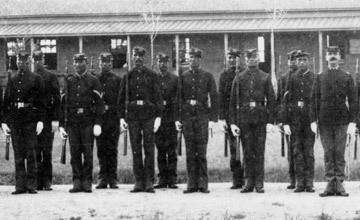
An American Indian Company of the Twenty-First Infantry taken at Fort Sidney, Nebraska. V101-20
In the end, the unstoppable tide of settlers, the near extinction of the massive buffalo herds, and the lust for gold on Indian land made it inevitable that the American Indians could not win this conflict. Most Indians ended up on reservations and by 1898 the Indian Wars were mostly over.
Whenever we talk about this project, people are always surprised that the widows of these men were still alive in the 1960s, considering that the so-called "Indian Wars" ended about 1890. Contacting these widows in 1962 seems like one of the "human wormhole" moments as discussed in a recent NPR blog, "Rasputin Was My Neighbor,"when sometimes events that seem to be in the distant past were experienced by someone you know, or when the overlap of two lifetimes can seem to stretch impossibly far back into the past. The Indian Wars period in which the husbands of these widows fought ended officially in 1898, when troops were pulled from the West to fight in the Spanish-American War in Cuba, Puerto Rico and the Philippines. If we assume the women that Rickey contacted were in their 80s or 90s, they would have been born between 1872-1882. Thus, those born in the 1870s may have married their husbands and lived in the west with them, while others were probably married years after their husbands left the Army. So there were quite a number of widows left, even in the 1960s, for Rickey to contact.
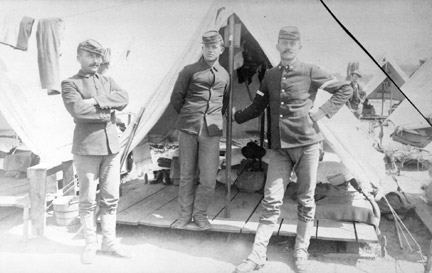
Sgt. Major Jefferson Heady and other soldiers of the First Infantry, Company F. V101-27
Rickey heard back from quite a few widows who filled out information sheets about the Army service of their husbands. Many offered the loan of documents and photographs for Rickey to copy. In addition to photographs and certificates, a few included transcripts of diaries or reminiscences of service in the Army in the West. Unfortunately, the copied certificates are barely legible now. The photographs are primarily of men in uniform, but also include some of the installations where they were stationed, and of soldiers at work and off duty. You can see a gallery of images from the collection here.
For collections in the archives, archivists put together documents called finding aids. These finding aids usually include an introduction to the collection detailing who put the papers together, why they are significant, and why and how they made their way to the institution.In the finding aid, the archivist explains how the collection is organized and provides a guide to what is in the boxes. In our finding aids we are very specific about the contents of the collection down to the folder level.Harry Heiss, the first archivist at the park, created the finding aid to this collection in 1989 and it is available here.
Information gathered from this research was used in exhibit planning for the Museum of Westward Expansion beneath the Gateway Arch, for the research report "The Soldier's Frontier", and for Don Rickey's book , Forty Miles a Day on Beans and Hay: The Enlisted Soldier Fighting the Indian Wars. Norman: University of Oklahoma Press, 1963.
For information about visiting the archives, see the web page here.
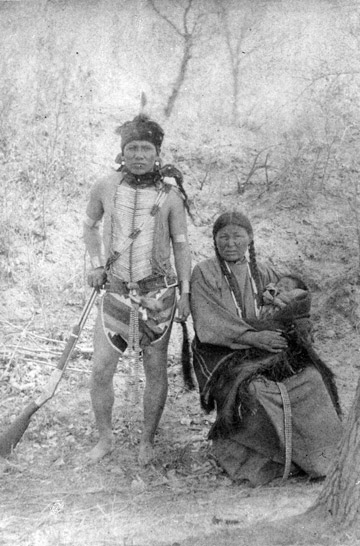
Warrior and woman holding baby at the Standing Rock Agency in North Dakota. V101-12
